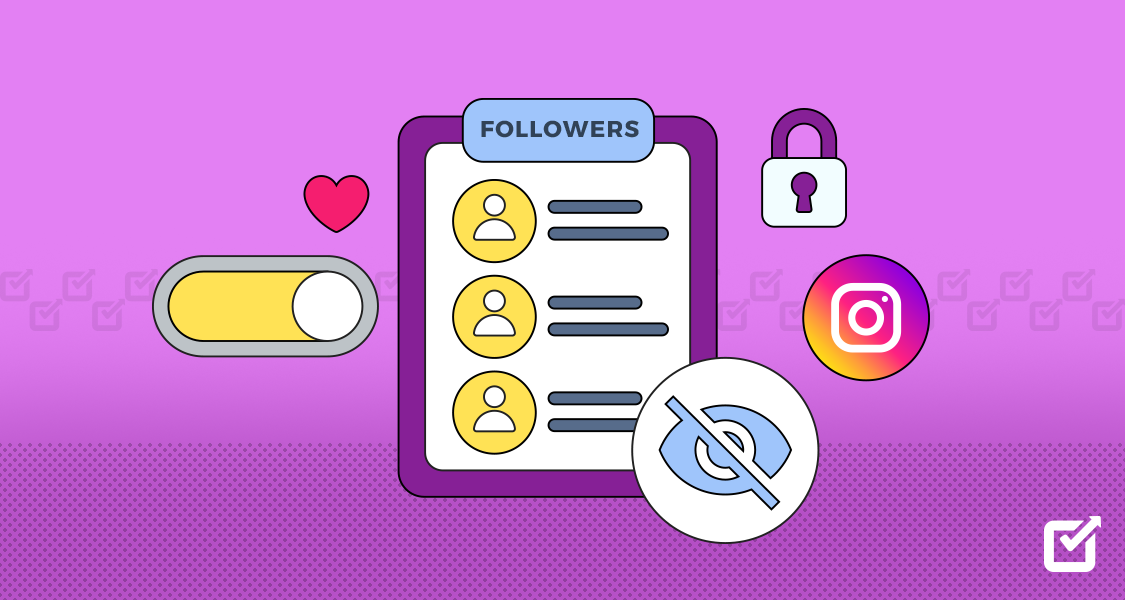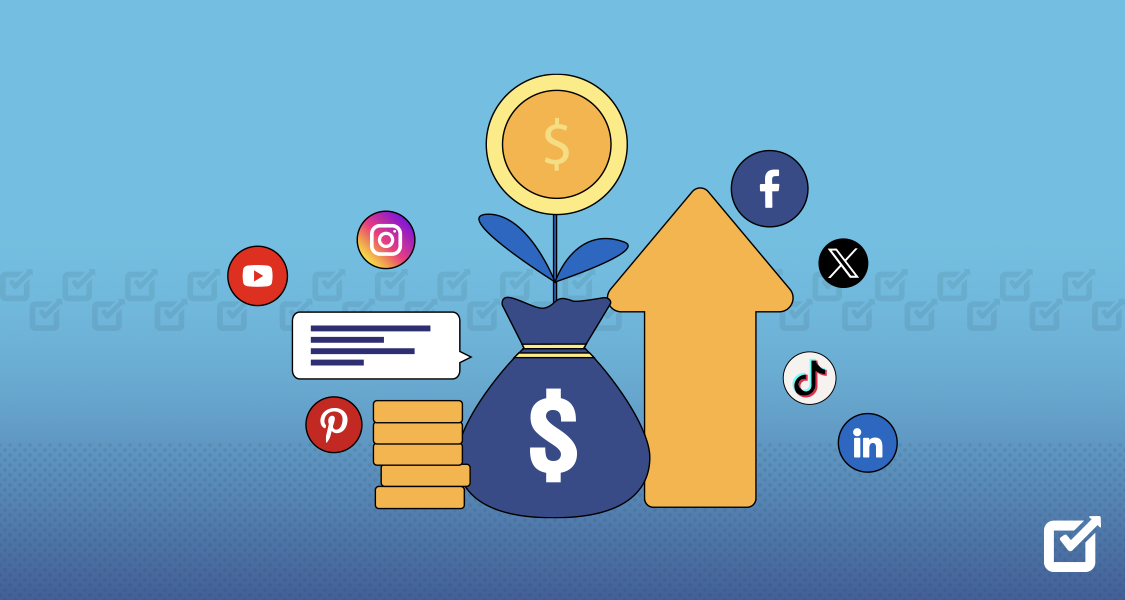Ever felt like you’re pouring your heart and soul into social media, but the results just aren’t reflecting the effort?
You’re not alone. Measuring and proving social media marketing’s return on investment (ROI) can be tricky. But there’s no need to panic just yet!
In this blog, we’ll explore social media ROI in detail. You’ll gain knowledge and insight on analytics tools that help you prove the value of your social media efforts and improve them for even greater results.
What Is ROI and What Does It Stand For?
Imagine you’re running a bakery, and you decide to promote your delicious cupcakes on social media. You post mouthwatering pictures, run targeted ads, and even host a cupcake decorating contest. But how do you know if all this effort is actually bringing in more customers and sales?
This is where ROI, or Return on Investment, comes in. It’s a way to measure the benefits you get from your social media efforts compared to the resources you put in.
Let’s break it down into two components:
- Benefits: These are the good things that happen from your social media activities. In our bakery example, this could be increased sales from people seeing your posts, website traffic from your ads, or mentions of your bakery online because of the contest.
- Resources: This is everything you invest in your social media presence. It could be the money you spend on ads, the time it takes to create content or the cost of any tools you use.
By calculating ROI, you can see if your social media efforts are actually bringing in more business than they’re costing you.
Here’s the basic formula:
ROI = (Benefits – Resources) / Resources * 100
So, let’s say your social media efforts brought in an extra $1,000 in sales, but you spent $200 on ads and 10 hours creating content (which you value at $20 an hour). Your ROI would be:
ROI = ($1,000 – $200 – $200) / ($200 + $200) * 100 = 300%
This means that for every dollar you invested in social media, you got $3 back! Pretty good, right?
Understanding your social media ROI helps you see if your efforts are paying off and allows you to make informed decisions about how to improve your social media strategy for even sweeter results.
Ready to Assess Your ROI?
Social Champ makes tracking and analyzing your social media campaigns a breeze. Try it out!
What Is Social Media ROI?
ROI, or return on investment, measures the effectiveness and profitability of your social media activities relative to the resources, time, and money you invest in them. It quantifies the value generated from your social media efforts compared to the associated costs.
Understanding social media ROI is crucial for businesses and organizations to assess the impact of their social media strategies, justify their investments, and optimize their campaigns for better outcomes.
Components of Social Media ROI
Investment: This includes the resources allocated to social media marketing, such as advertising spend, content creation costs, employee salaries, tools, and technology expenses.
Returns: Returns encompass the outcomes or benefits derived from social media efforts. These can vary depending on the objectives set for a campaign and may include metrics like increased brand awareness, website traffic, lead generation, customer engagement, sales, or revenue.

Calculating Social Media ROI
Calculating social ROI involves comparing the returns generated from social media activities against the investment made. Here’s a basic formula for calculating ROI:
ROI=(Investment Returns−Original Investment)×100%
Importance of Social Media ROI
- Measuring Effectiveness: ROI provides a tangible way to measure the effectiveness of social media efforts. It helps determine which strategies deliver the highest returns and which ones need optimization.
- Budget Allocation: By understanding social media ROI statistics channels and campaigns, businesses can allocate their marketing budgets more efficiently, focusing resources on platforms and strategies that yield the best results.
- Demonstrating Value: A positive ROI is essential for justifying continued investment in social media marketing to stakeholders, executives, or clients. It provides evidence of the value generated by social media efforts and helps secure buy-in for future initiatives.
- Optimization: Analyzing social media ROI statistics allows businesses to identify areas for improvement and optimization. Whether it’s refining targeting, adjusting messaging, or reallocating resources, insights from ROI analysis enable continuous refinement of social media strategies for better performance.
Related Article: How to Make Money on Social Media in 2024: A Step-by-Step Guide
Why Should You Track Social Media ROI?
Tracking social ROI is essential for several reasons:
- Effectiveness Assessment: By measuring ROI, businesses can assess the effectiveness of their social media efforts. This analysis helps understand which strategies yield the best results and which ones need improvement or optimization.
- Resource Allocation: Tracking ROI allows businesses to allocate their resources, including time, budget, and manpower, more efficiently. By identifying the channels and tactics that deliver the highest returns, organizations can prioritize their investments for maximum impact.
- Justification of Investment: Demonstrating a positive ROI is crucial for justifying continued investment in social media marketing to stakeholders, executives, or clients. It provides tangible evidence of the value generated by social media efforts, helping secure buy-in for future initiatives.
- Optimization Opportunities: Insights from ROI analysis enable businesses to identify areas for improvement and optimization in their social media strategies. Whether refining targeting, adjusting messaging, or reallocating resources, ROI tracking helps continuously optimize campaigns for better performance.
- Strategic Decision Making: Understanding social media informs strategic decision-making processes. It helps businesses set realistic goals, evaluate the feasibility of different approaches, and make data-driven adjustments to their social media strategies.
- Competitive Benchmarking: Tracking social media allows businesses to benchmark their performance against industry standards and competitors. Analyzing how competitors leverage social media and comparing their ROI metrics can provide valuable insights for staying competitive in the market.
- ROI-driven Marketing: Focusing on ROI encourages a more results-oriented approach to social media marketing. Rather than chasing vanity metrics, businesses prioritize activities that drive tangible business outcomes, such as lead generation, customer acquisition, and revenue growth.
- Continuous Improvement: By consistently tracking ROI and analyzing performance metrics, businesses can engage in a cycle of constant improvement. They can test new ideas, learn from successes and failures, and refine their social media strategies to achieve better results.
Overall, tracking ROI is essential for businesses looking to maximize the value of their social media investments, drive tangible business outcomes, and stay competitive in today’s digital landscape.
Featured Article: Top 15+ AI Tools for Social Media in 2024
What’s an Example of Social Media ROI?
Social media return on investment (ROI) refers to measuring the benefits and gains achieved from the resources invested in social media marketing efforts. It helps businesses estimate the effectiveness of their social media strategies and determine whether the time, effort, and money spent on these platforms are generating the desired results. Here are some social media ROI examples.
Example: E-commerce Company Launching a New Product
Let’s consider an e-commerce company that specializes in selling eco-friendly home products. They are launching a new line of sustainable kitchen accessories and have decided to promote it through various social media channels heavily.
Defining Goals and Objectives
The company sets clear goals and objectives before launching the social media campaign. In this case, the primary goal is to drive new product line sales. Secondary objectives include increasing brand awareness, engaging with the target audience, and building a loyal customer base.
Identifying Key Performance Indicators (KPIs)
To measure the campaign’s success, the company identifies relevant KPIs. These may include:
- Website traffic from social media channels
- Social media engagement rates (likes, shares, comments)
- Conversion rates (visitors to customers)
- Customer acquisition cost
- Revenue generated from social media referrals
Allocating Resources
The company allocates a dedicated budget for the social media campaign, including costs for content creation, paid advertising, influencer collaborations, and social media management tools. Additionally, they assign a team to handle the campaign’s execution and monitoring.
Executing the Social Media Campaign
The company launches a multi-pronged social media campaign across various platforms, such as Instagram, Facebook, and TikTok. Strategies may include:
- Creating visually appealing content showcasing the new product line
- Running targeted paid advertising campaigns
- Collaborating with influencers in the eco-friendly and sustainable living space
- Engaging with the target audience through interactive contests and giveaways
- Leveraging user-generated content and social proof
Tracking and Measuring Results
Throughout the campaign, the company closely monitors the identified KPIs using analytics tools and social media management platforms. They track website traffic, engagement, conversion, and revenue generated from social media referrals.
Calculating Social Media ROI
After a predetermined period, the company calculates the ROI by comparing the revenue generated from the campaign against the total investment. Here’s a hypothetical calculation:
- Total investment in the social media campaign: $50,000 (including content creation, paid advertising, influencer collaborations, and management tools)
- Revenue generated from social media referrals: $150,000
- ROI = (Revenue – Investment) / Investment
- ROI = ($150,000 – $50,000) / $50,000
- ROI = 2 (or 200%)
In this example, the company achieved an ROI of 200%, meaning that for every dollar invested in the social media campaign, it generated $2 in revenue.
Analyzing and Optimizing
The company doesn’t stop at calculating the ROI. It dives deeper into the analytics to understand what worked well and what could be improved. For instance, it may find that Instagram performed better than Facebook in terms of engagement and conversions. Or, it may discover that influencer collaborations drove higher-quality traffic compared to paid advertising.
Based on these insights, the company can refine its social media strategy, reallocate resources more effectively, and optimize future campaigns to achieve even better results.
It’s important to note that social media ROI examples are not solely limited to direct revenue generation. Depending on the business goals, companies may also consider factors such as brand awareness, customer loyalty, and customer lifetime value when estimating the overall return on their social media investments.
How to Improve Your Social Media ROI
Improving media ROI involves implementing strategies aimed at maximizing the effectiveness and profitability of your social media efforts. Here are some key tactics to enhance your social ROI:
- Know Your Audience: Understand your target audience’s demographics, interests, preferences, and online behavior. Adjust your content and messaging to resonate with your audience, increasing engagement and conversion rates.
- Create Decent Content: Produce high-quality, relevant, and engaging content that adds value to your audience. Experiment with different content formats like videos, images, infographics, and blog posts to keep your audience interested and drive interaction.
- Optimize Posting Times and Frequency: Based on your audience’s online activity patterns, identify the optimal posting times and frequencies on each social media platform. Use social media analytics tools to track engagement metrics and adjust your posting schedule accordingly.

A snapshot of Social Champ’s best time to post a report - Utilize Paid Advertising: Invest in targeted social media advertising campaigns to reach a wider audience and drive specific actions, such as website visits, lead generation, or product purchases. Use a Social media ROI calculator to reach users based on demographics, interests, and behaviors.
- Engage with Your Audience: Actively engage with your audience by responding promptly to comments, messages, and mentions. Encourage conversations, ask questions, and solicit feedback to foster a sense of community and build relationships with your followers.
- Influencer Partnerships: Collaborate with influencers and industry experts to amplify your brand’s reach and credibility. Choose influencers whose values align with your brand and whose followers match your target audience demographics.
- Monitor and Analyze Performance: Regularly monitor key performance indicators (KPIs) such as engagement rates, click-through rates, conversion rates, and return on ad spend (ROAS). Use analytics tools, like Social Champ, to track performance metrics and identify areas for improvement.

A snapshot of post analysis by Social Champ - Test and Iterate: Continuously test different strategies, content types, ad formats, and targeting options to optimize performance. Conduct A/B tests to compare variations and refine your approach based on data-driven insights.
- Integrate with Other Marketing Channels: Integrate your social media efforts with other marketing channels, such as email marketing, content marketing, and search engine optimization (SEO), to create a cohesive and synergistic marketing strategy. Cross-promote content and campaigns across channels to maximize reach and effectiveness.
By reading the social media ROI book and continuously refining your approach based on data and insights, you can improve your ROI and achieve better business outcomes from your social media efforts.
In Conclusion
Proving and improving social media ROI is crucial to justify investments in social media marketing and drive tangible business outcomes.
By implementing strategies, such as setting clear objectives, understanding your audience, creating compelling content, leveraging paid advertising, engaging with your audience, and monitoring performance metrics, you can demonstrate the effectiveness of your social media efforts and optimize them for better results.
Continuous experimentation, analysis, and iteration are key to refining social media strategies and maximizing ROI over time. With a data-driven approach and a focus on delivering value to their audience, you can enhance your ROI and achieve your marketing objectives.
Frequently Asked Questions
1. What Is a Good Media ROI?
2. What Is a Very High ROI?
In such cases, businesses generate substantial returns relative to their investment, demonstrating exceptional efficiency and effectiveness in their marketing efforts. Achieving a very high ROI usually requires strategic planning, targeted execution, and effective measurement and optimization throughout the campaign.
3. Is ROI Better Than Profit?
4. What Is Margin ROI?
5. How to Calculate Social Media ROI?
To calculate revenue generated from social media, track conversions directly because of your social media campaigns, such as sales from referral links, leads generated, or other measurable outcomes.











